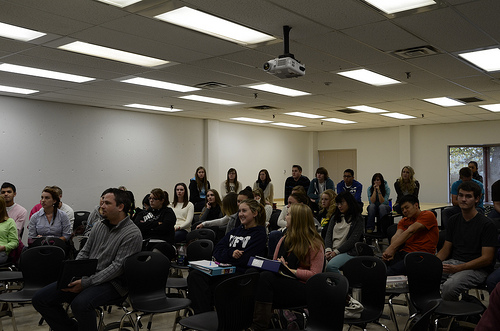By Dessa Bayrock (The Cascade) – Email
Print Edition: March 27, 2013
I am sick to death of small classes.
It’s something that UFV prides itself on, and it’s a bragging right that seems to sneak into every description and pamphlet the university sends anyone. Look at how small and personal we are! Our class sizes are an average of 30, including the professor! Not like those larger universities, where you get lost in a crowded lecture hall with 150 other students. UFV students enjoy a more comfortable and intimate learning atmosphere instead. Lucky us!
That’s how I used to feel about it, anyway – exactly how the promotional material told me to. But I’m staring down my sixth year at this institution, and I’m a little more cynical now than when I first arrived. Are the benefits of smaller classes really that remarkable?
Are our classes really even all that small?
According to UBC’s website, 50 per cent of their first-year classes have more than 100 students. The SFU website states classes are 82 students on average, and will never exceed 200 – which, incidentally, is what they advertise as “smaller class sizes.”
So it’s safe to say that UFV classes are, at the very least, comparatively smaller.
But that doesn’t mean small.
Over the past five years, I’ve learned that 30 students is not a small amount of students. It’s small enough that the professor still feels the need to cultivate one-on-one interactions with every student, but it’s a large enough class that no student will feel truly cultivated.
It’s small enough that every student should be able to contribute to discussion, but it’s a large enough class that there isn’t necessarily enough time for every student to speak – let alone get a checkmark in the participation column.
Thirty students is a small enough number that professors can theoretically handle their classes without the aid of a TA, but it’s a large enough that a professor will still forget names.
It’s large enough that not every student wants to be there, but small enough that an absence is painfully obvious.
Thirty students is not a small class.
Before the economy crashed and everyone headed back to school, and barely after UFV had gained university status, I was in a class that had six students in it. They had to run it because it was a Chilliwack section, but no one wanted to take it – also because it was a Chilliwack section.
It was my very first semester, and I didn’t know how good I had it until years later.
Each student got a tremendous amount of attention and respect, both from professor and other students. Rather than take notes from the board or listen to a lecture, the class was a constant discussion group – and everyone came prepared, because they knew they’d have to deliver. There was no hiding. You were there, or you weren’t; you were engaged and paying attention or it would soon become painfully obvious.
That was a small class. Intimate. Comfortable. All the things UFV advertises in its class sizes.
But there’s another end of the spectrum. As a multitude of reasons have pushed people back to school and brought them to UFV, classes have become more crowded than ever before. Last year, I took a lower-level course. The odds were in my favour; as an upper-level student with a fairly decent GPA, my registration date scored me a spot in the class.
Others were not so lucky. There was a waitlist of 27.
The professor allowed an extra five or six people into the class, assuming someone would drop and things would even out. No one did.
We quickly learned to be early to class – assuming everyone attended lecture, the last student in the door wouldn’t have a chair.
At this point, UFV is at a crossroads; it’s getting to the point where we have to decide if we want to be the next UBC or SFU, or go back to our roots as a community college. Class size is one of the factors we’ll have to come to a decision about. Can we go back to classes of six or a dozen people, or do we upgrade to lecture halls that can hold 150 students at a time?
One thing is clear, at least in my mind – we can’t keep kidding ourselves that 30 students is a small class.
It’s not.


